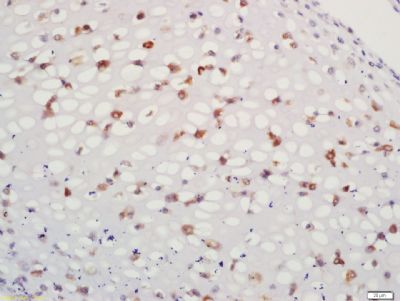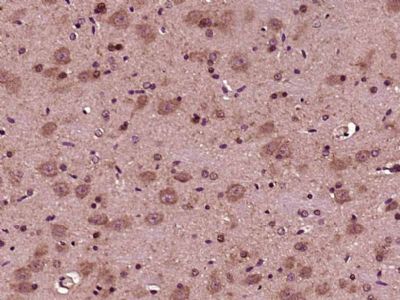ACAN Polyclonal Antibody
Purified Rabbit Polyclonal Antibody (Pab)
- 产品详情
- 实验流程
Application
| IHC-P, IHC-F, IF |
|---|---|
| Primary Accession | P16112 |
| Reactivity | Rat, Pig, Dog, Bovine |
| Host | Rabbit |
| Clonality | Polyclonal |
| Calculated MW | 261329 Da |
| Physical State | Liquid |
| Immunogen | KLH conjugated synthetic peptide derived from mouse ACAN |
| Isotype | IgG |
| Purity | affinity purified by Protein A |
| Buffer | 0.01M TBS (pH7.4) with 1% BSA, 0.02% Proclin300 and 50% Glycerol. |
| SUBCELLULAR LOCATION | Secreted, extracellular space, extracellular matrix. |
| SIMILARITY | Belongs to the aggrecan/versican proteoglycan family.Contains 1 C-type lectin domain.Contains 1 EGF-like domain.Contains 1 Ig-like V-type (immunoglobulin-like) domain.Contains 4 Link domains.Contains 1 Sushi (CCP/SCR) domain. |
| SUBUNIT | Interacts with FBLN1. Interacts with COMP. |
| Post-translational modifications | Contains mostly chondroitin sulfate, but also keratan sulfate chains, N-linked and O-linked oligosaccharides. The release of aggrecan fragments from articular cartilage into the synovial fluid at all stages of human osteoarthritis is the result of cleavage by aggrecanase. |
| DISEASE | Spondyloepiphyseal dysplasia type Kimberley (SEDK) [MIM:608361]: Spondyloepiphyseal dysplasias are a heterogeneous group of congenital chondrodysplasias that specifically affect epiphyses and vertebrae. The autosomal dominant SEDK is associated with premature degenerative arthropathy. Note=The disease is caused by mutations affecting the gene represented in this entry.Spondyloepimetaphyseal dysplasia aggrecan type (SEMD-ACAN) [MIM:612813]: A bone disease characterized by severe short stature, macrocephaly, severe midface hypoplasia, short neck, barrel chest and brachydactyly. The radiological findings comprise long bones with generalized irregular epiphyses with widened metaphyses, especially at the knees, platyspondyly, and multiple cervical-vertebral clefts. Note=The disease is caused by mutations affecting the gene represented in this entry.Osteochondritis dissecans short stature and early-onset osteoarthritis (OD) [MIM:165800]: A type of osteochondritis defined as a separation of cartilage and subchondral bone from the surrounding tissue, primarily affecting the knee, ankle and elbow joints. It is clinically characterized by multiple osteochondritic lesions in knees and/or hips and/or elbows, disproportionate short stature and early-onset osteoarthritis. Note=The disease is caused by mutations affecting the gene represented in this entry. |
| Important Note | This product as supplied is intended for research use only, not for use in human, therapeutic or diagnostic applications. |
| Background Descriptions | Aggrecan is a member of a family of large, aggregating proteoglycans (also including versican, brevican and neurocan) which is found in articular cartilage. Aggrecan is composed of three major domains: G1, G2, and G3. Between the G1 and G2 domains there is an interglobulin region (IGD). The IGD region is the major site of cleavage by specific proteases like metalloproteinases (MMPs) and aggrecanase. Aggrecan cleavage has been associated with a number of degenerative diseases including rheumatoid arthritis and osteoarthritis. There is evidence that this family of proteoglycans modulates cell adhesion, migration, and axonal outgrowth in the CNS. |
| Gene ID | 176 |
|---|---|
| Other Names | Aggrecan core protein, Cartilage-specific proteoglycan core protein, CSPCP, Chondroitin sulfate proteoglycan core protein 1, Chondroitin sulfate proteoglycan 1, Aggrecan core protein 2, ACAN, AGC1, CSPG1, MSK16 |
| Target/Specificity | Restricted to cartilages. |
| Dilution | IHC-P=1:100-500,IHC-F=1:100-500,IF=1:100-500 |
| Format | 0.01M TBS(pH7.4) with 1% BSA, 0.09% (W/V) sodium azide and 50% Glyce |
| Storage | Store at -20 °C for one year. Avoid repeated freeze/thaw cycles. When reconstituted in sterile pH 7.4 0.01M PBS or diluent of antibody the antibody is stable for at least two weeks at 2-4 °C. |
| Name | ACAN |
|---|---|
| Synonyms | AGC1, CSPG1, MSK16 |
| Function | This proteoglycan is a major component of extracellular matrix of cartilagenous tissues. A major function of this protein is to resist compression in cartilage. It binds avidly to hyaluronic acid via an N-terminal globular region. |
| Cellular Location | Secreted, extracellular space, extracellular matrix {ECO:0000250|UniProtKB:P07898} |
| Tissue Location | Detected in fibroblasts (at protein level) (PubMed:36213313). Restricted to cartilage (PubMed:7524681) |
Research Areas
For Research Use Only. Not For Use In Diagnostic Procedures.
Application Protocols
Provided below are standard protocols that you may find useful for product applications.
终于等到您。ABCEPTA(百远生物)抗体产品。
点击下方“我要评价 ”按钮提交您的反馈信息,您的反馈和评价是我们最宝贵的财富之一,
我们将在1-3个工作日内处理您的反馈信息。
如有疑问,联系:0512-88856768 tech-china@abcepta.com.
¥ 1,500.00
Cat# AP54583























 癌症的基本特征包括细胞增殖、血管生成、迁移、凋亡逃避机制和细胞永生等。找到癌症发生过程中这些通路的关键标记物和对应的抗体用于检测至关重要。
癌症的基本特征包括细胞增殖、血管生成、迁移、凋亡逃避机制和细胞永生等。找到癌症发生过程中这些通路的关键标记物和对应的抗体用于检测至关重要。 为您推荐一个泛素化位点预测神器——泛素化分析工具,可以为您的蛋白的泛素化位点作出预测和评分。
为您推荐一个泛素化位点预测神器——泛素化分析工具,可以为您的蛋白的泛素化位点作出预测和评分。 细胞自噬受体图形绘图工具为你的蛋白的细胞受体结合位点作出预测和评分,识别结合到自噬通路中的蛋白是非常重要的,便于让我们理解自噬在正常生理、病理过程中的作用,如发育、细胞分化、神经退化性疾病、压力条件下、感染和癌症。
细胞自噬受体图形绘图工具为你的蛋白的细胞受体结合位点作出预测和评分,识别结合到自噬通路中的蛋白是非常重要的,便于让我们理解自噬在正常生理、病理过程中的作用,如发育、细胞分化、神经退化性疾病、压力条件下、感染和癌症。







